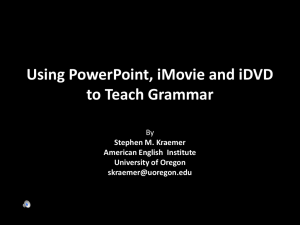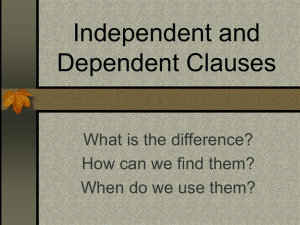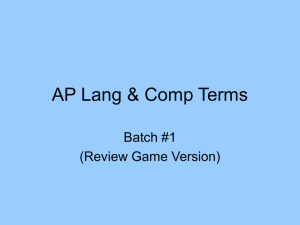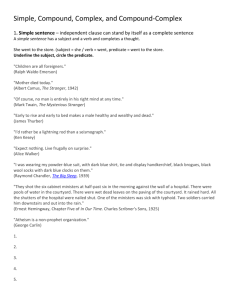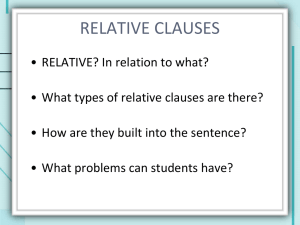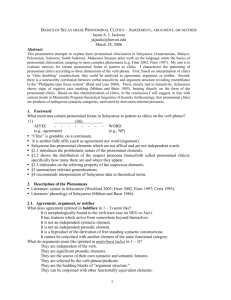ANT/ENG/LIN 516 - Study guide for the final exam
advertisement
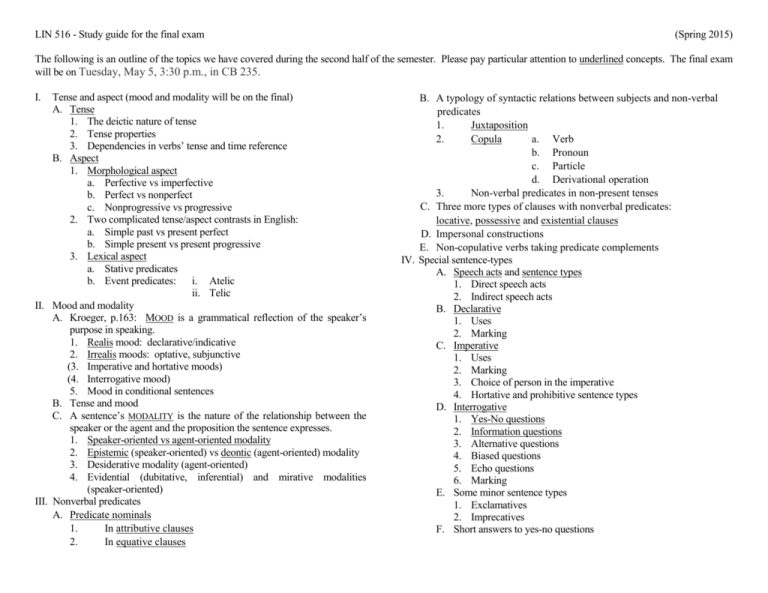
LIN 516 - Study guide for the final exam (Spring 2015) The following is an outline of the topics we have covered during the second half of the semester. Please pay particular attention to underlined concepts. The final exam will be on Tuesday, May 5, 3:30 p.m., in CB 235. I. Tense and aspect (mood and modality will be on the final) A. Tense 1. The deictic nature of tense 2. Tense properties 3. Dependencies in verbs’ tense and time reference B. Aspect 1. Morphological aspect a. Perfective vs imperfective b. Perfect vs nonperfect c. Nonprogressive vs progressive 2. Two complicated tense/aspect contrasts in English: a. Simple past vs present perfect b. Simple present vs present progressive 3. Lexical aspect a. Stative predicates b. Event predicates: i. Atelic ii. Telic II. Mood and modality A. Kroeger, p.163: MOOD is a grammatical reflection of the speaker’s purpose in speaking. 1. Realis mood: declarative/indicative 2. Irrealis moods: optative, subjunctive (3. Imperative and hortative moods) (4. Interrogative mood) 5. Mood in conditional sentences B. Tense and mood C. A sentence’s MODALITY is the nature of the relationship between the speaker or the agent and the proposition the sentence expresses. 1. Speaker-oriented vs agent-oriented modality 2. Epistemic (speaker-oriented) vs deontic (agent-oriented) modality 3. Desiderative modality (agent-oriented) 4. Evidential (dubitative, inferential) and mirative modalities (speaker-oriented) III. Nonverbal predicates A. Predicate nominals 1. In attributive clauses 2. In equative clauses B. A typology of syntactic relations between subjects and non-verbal predicates 1. Juxtaposition 2. Copula a. Verb b. Pronoun c. Particle d. Derivational operation 3. Non-verbal predicates in non-present tenses C. Three more types of clauses with nonverbal predicates: locative, possessive and existential clauses D. Impersonal constructions E. Non-copulative verbs taking predicate complements IV. Special sentence-types A. Speech acts and sentence types 1. Direct speech acts 2. Indirect speech acts B. Declarative 1. Uses 2. Marking C. Imperative 1. Uses 2. Marking 3. Choice of person in the imperative 4. Hortative and prohibitive sentence types D. Interrogative 1. Yes-No questions 2. Information questions 3. Alternative questions 4. Biased questions 5. Echo questions 6. Marking E. Some minor sentence types 1. Exclamatives 2. Imprecatives F. Short answers to yes-no questions V. Subordinate clauses A. Coordination B. Subordination 1. Differences between main clauses and subordinate clauses a. Verb form b. Subject c. Word order d. Matrix verb e. Complementizer 2. Complement clauses 3. Adjunct clauses 4. Relative clauses a. Restrictive vs nonrestrictive vs free relative clauses b. The structure of relative clauses i. How is the relativized NP altered? ii. Is the relative construction marked in any other way? If so, how? iii. How is the head NP altered? iv. What structural position does the relative clause occupy with respect to the main clause? c. Differences among distinct relative clause types d. The Keenan-Comrie Accessibility Hierarchy e. Relativization strategies and hierarchy constraints VI. Derivational morphology and word formation A. Inflectional morphology vs lexical morphology 1. Inflectional morphology 2. Lexical morphology: a. Derivational morphology b. Compounding 3. Differences between inflection and derivation a. Derivational morphology may change the part of speech or lexical meaning of the stem with which it joins. b. Inflected forms are syntactically determined. c. Inflectional paradigms are complete and semantically regular. d. Inflection “closes” words. 4. Differences between compounds and phrases: phonological, morphological, semantic and syntactic B. Word-formation rules E.g. for the noun WRITER: 1. Definition of the rule of agent-noun derivation: The agent-noun derivative of the lexeme L has Phonology: Xer where: X is L’s stem Syntax: N V is L’s category Semantics: “one who Ys” “Y” is L’s meaning 2. Lexical entry: WRITER is the agent-noun derivative of WRITE VII. Valence-changing morphology A. What is valence? B. Valence-changing operations 1. Valence-decreasing operations a. Passives (suppression of A, promotion of O) i. analytic vs synthetic ii. expression of agent iii. pseudopassives iv. deponent verbs b. Antipassives (suppression of O, promotion of A) c. Impersonals (suppression of A or S, no promotion) d. Noun incorporation e. Reflexives and reciprocals 2. A valence-transposing operation: Dative shift 3. Valence-increasing operations a. Possessor raising b. Applicatives c. Causatives VIII. Allomorphy A. What are allomorphs? B. Factors conditioning the use of an allomorph 1. Phonological conditions 2. Lexical conditions 3. Morphological conditions C. Formal relations between allomorphs 1. Basic/derived relation 2. Default/override relation D. Inflection classes 1. Declensions 2. Conjugations IX. Nonlinear morphology: reduplication, infixation, circumfixation, mutation, suprafixation, subtraction, metathesis X. Clitics A. What is a clitic? B. Proclitics and enclitics C. Two types of clitics 1. Simple clitics: a. Bound words b. Phrasal affixes 2. Special clitics: a. Verbal clitics b. Second-position clitics

